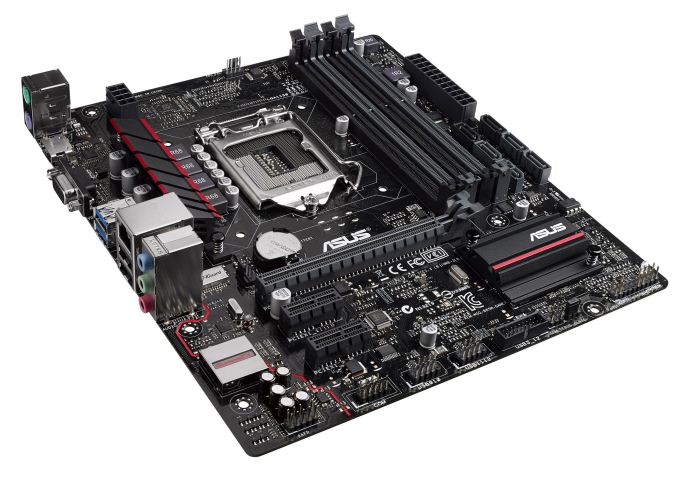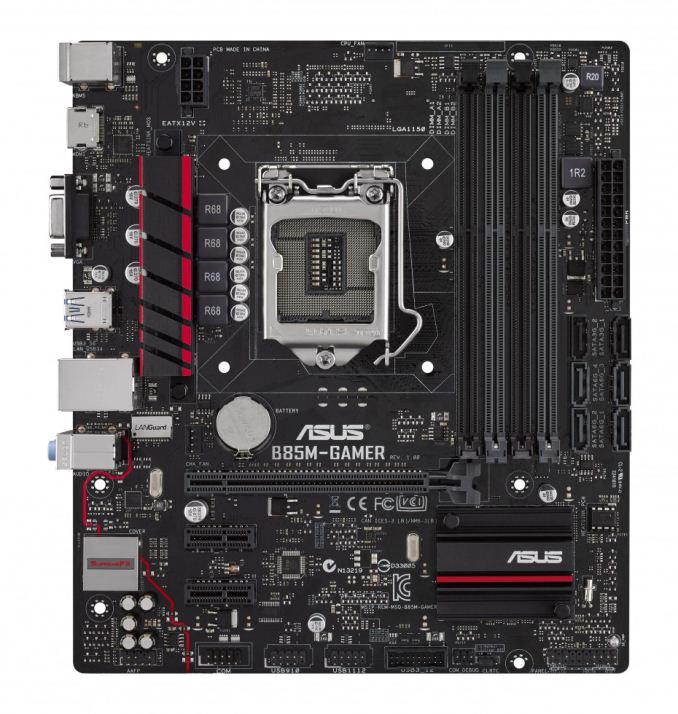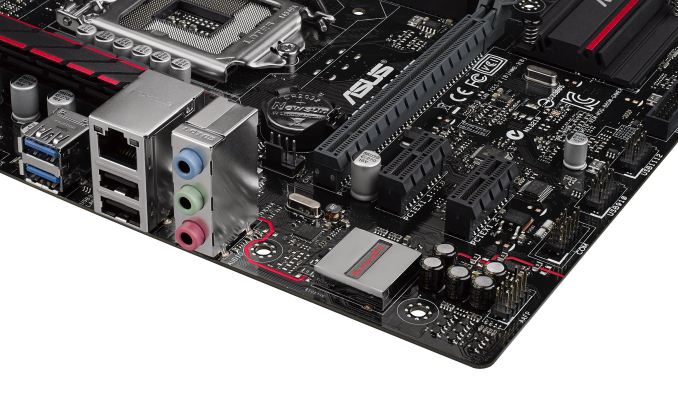ASUS ROG Announces the B85M-Gamer Motherboard
by Ian Cutress on January 31, 2015 11:06 AM EST
In recent months it would seem that ASUS’ Republic of Gamers brand has split into some very distinct segments. We used to only have three SKUs to choose from: the Extreme, the Formula and the mATX Gene. Along came the mini-ITX Impact, then the Ranger, and then something called the Pro Gamer.
Today we received a press release regarding the announcement of the B85M-Gamer, which has very little mentioning of ROG at all. Typically ROG is ASUS’ high-end gaming brand, so it would make sense to align something more budget just under the ‘Gamer’ name rather than a full blown ROG. The B85M-Gamer, despite being a business chipset, it going for the cheaper Intel market which already includes non-overclocking products from GIGABYTE and MSI. This market attacks the price/performance segment for home users and gamers along with the system integrators or businesses such as cyber cafés in Asia who want a gaming angle.
The board is mostly black with red accents featuring a four-phase DIGI+ power solution, four SATA 6 Gbps, two SATA 3 Gbps, and a single PCIe 3.0 x16 slot. Audio comes under the ROG SupremeFX banner, meaning an enhanced Realtek ALC1150 solution with PCB separation, additional filter caps, a headphone amplifier for up to 300 ohm headphones and an EMI shield. The Intel NIC is paired with LANGuard for surge protection to defend against lightning strikes, and one would assume that the AI Suite 3 software also caters for some element of networking control. ASUS is reporting that the configuration they have selected has better UDP throughput for gaming than other solutions.
Four USB 3.0 ports and support for 32GB of DRAM is also present. ASUS hope that pairing this board with a Pentium, Core i3 or even an i5, as well as a mid-range graphics card, can provide an effective gaming tool in the B85 market for mATX builds.
As this press release came via ROG rather than ASUS USA, it is hard to tell if it will be stocked in the US or is more focused in Europe/Asia. As a result, no pricing or release date has been attached.
Source: ASUS ROG














30 Comments
View All Comments
CaedenV - Saturday, January 31, 2015 - link
This is what is missing. Most people do not overclock. Most people don't need zXX chipset features. All that most people need is a solid basic motherboard, and i5 chip, and a good GPU. Throw in some things like nice automatic fan control, a decent onboard audio chip, and maybe WiFi, and you have yourself a perfect game rig more than capable of handling the toughest 1080p and 1440p demands.Unless you are overclocking, need multiple GPUs, or some other exotic needs (multiple LAN ports) then you can save some serious money with a solid basic system. There is just so little need for the average gamer to shell out $130+ on a motherboard.
bebimbap - Saturday, January 31, 2015 - link
I think it was Ian or could be another Anandtech employee, but they said they recommended zXX platform for a system build just because of the zXX feature set and not because of the overclocking ability. Though b and z both have 6gbps sata, z has "Lake Tiny" or SSD caching. and even if you don't need that or more usb3 ports, the z's ability to have mpcie ssd for a cleaner build seems worth the difference alone.It all depends on the budget so i'm not disagreeing with you CaedenV, but overclocking isn't the only reason people get z.
emgarf - Sunday, February 1, 2015 - link
^ ...and that's exactly why I buy more expensive MBs - I never overclock, but the extra features -seem- like worthwhile insurance to extend the useful life of the purchase. (I say "seem" because the extra features have rarely come in handy...)Samus - Sunday, February 1, 2015 - link
I've always purchased H87/H97's and overclock successfully on them. The only thing really missing on the H-series is memory overclocking and high-clocking RAM has little benefit and an incredibly high price premium; 1600MHz is fine imho.I'm happy to see the B-series chipset make it to a board like this with good audio and network options.I'd consider an inexpensive Xeon like a E3-1230v3 (they're under $200) for a powerful, inexpensive gaming PC.
StrangerGuy - Saturday, January 31, 2015 - link
Shhh you don't talk about that elephant in the room. We can't have well-informed enthusiasts learn obvious facts about mobos that we have known for years.peterfares - Sunday, February 1, 2015 - link
Most people don't overclock, but what about gamers building their own computer? (the ones buying these boards) I think they're far more likely to overclock, especially when you can easily bump up the clock a few hundred megahertz without any fuss.Murloc - Sunday, February 1, 2015 - link
it's a marketing trick, you don't cannibalize the high end sector by selling cheap chipsets with just the features that 99% of people need.Of course most gamers and non-overclockers do not need anything more than the cheaper motherboards.
I usually strike in the middle by buying the mainstream chipset standard motherboard, but not the low cost chipset (out of fear of it having some limitation, I'm a victim of marketing too).
Morawka - Saturday, January 31, 2015 - link
Historically even asus's low budget motherboards, are typically $30-$40 more than everyone else. We shall see when a price is announced. I'd like for them to make a compelling board at AsRock Prices.Wall Street - Saturday, January 31, 2015 - link
I think that this board can make a lot of sense at the right price, except for the one glaring problem. In 2015, four back panel USB connectors is not OK. You can add another six (two of which are 3.0) via headers, but this USB situation is just not acceptable even for a budget board.phamhlam - Saturday, January 31, 2015 - link
Why? How many people use more than six usb connectors? Most people only need 3. Keyboard, mouse, and USB.